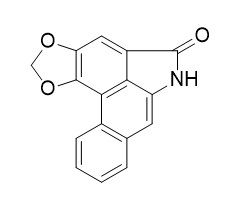Aristololactam II
Reference standards.
Inquire / Order:
manager@chemfaces.com
Technical Inquiries:
service@chemfaces.com
Tel:
+86-27-84237783
Fax:
+86-27-84254680
Address:
1 Building, No. 83, CheCheng Rd., Wuhan Economic and Technological Development Zone, Wuhan, Hubei 430056, PRC
Providing storage is as stated on the product vial and the vial is kept tightly sealed, the product can be stored for up to
24 months(2-8C).
Wherever possible, you should prepare and use solutions on the same day. However, if you need to make up stock solutions in advance, we recommend that you store the solution as aliquots in tightly sealed vials at -20C. Generally, these will be useable for up to two weeks. Before use, and prior to opening the vial we recommend that you allow your product to equilibrate to room temperature for at least 1 hour.
Need more advice on solubility, usage and handling? Please email to: service@chemfaces.com
The packaging of the product may have turned upside down during transportation, resulting in the natural compounds adhering to the neck or cap of the vial. take the vial out of its packaging and gently shake to let the compounds fall to the bottom of the vial. for liquid products, centrifuge at 200-500 RPM to gather the liquid at the bottom of the vial. try to avoid loss or contamination during handling.
Mol Pharm.2018, 15(8):3285-3296
Nutrients.2023, 15(4):954.
Plants (Basel).2023, 12(11):2107.
J Chem Inf Model.2021, 61(11):5708-5718.
Int J Biol Macromol.2025, 292:139225.
J of Food Quality2020, 8851285.
Natural Product Sciences2024, 30(1):8-13.
Food Chem. 2020, 320:126530
Front Pharmacol.2023, 14:1244655.
Cytotechnology2022, s10616
Related and Featured Products
J Nat Med. 2010 Oct;64(4):442-51.
Studies on morphology and aristolochic acid analogue constituents of Asarum campaniflorum and a comparison with two official species of Asari radix et rhizoma.[Pubmed:
20640524]
Dried whole herbs or roots and rhizomes of Asarum campaniflorum have been sold under the trade name Xixin and used as folk remedies in its producing areas for a long time. In order to avoid the misuse of A. campaniflorum as official species of Xixin (Asari radix et rhizoma), a comparative study based on the morphological and phytochemical analysis of the aerial and underground parts was carried out.
METHODS AND RESULTS:
The usual morphological methods and a microscopic imaging system were used. The results show that A. campaniflorum could be easily distinguished from two official species (Asarum sieboldii and A. heterotropoides var. mandshuricum) by the diameter of thicker roots (1.3-2.7 mm), distinct large parenchymatous cells in phloem of roots, and the size of oil cells in upper leaf epidermises [(40)80-140(174) microm in diameter, where numbers in parentheses are for rare cases], etc. Nine aristolochic acid analogues (AAAs) were identified and estimated by high-performance liquid chromatography-diode array detection (HPLC-DAD). The aerial and underground parts of A. campaniflorum contained 3-4 AAAs, i.e., aristololactam-II-N-beta-D-glucoside (AL-II-Glc), aristololactam I (AL-I), Aristololactam II (AL-II), and aristolochic acid I (AA-I), while only AL-I was detected in underground parts of A. sieboldii and no AAAs were detected in underground parts of A. heterotropoides var. mandshuricum. The respective contents (in mg/g) in aerial and underground parts of A. campaniflorum, were as follows: AL-I, 0.06-0.12, 0.05-0.10; AL-II, 0.03-0.04, 0.01-0.03; AA-I, 0.01-0.02, 0.0-0.0.
CONCLUSIONS:
These data suggest A. campaniflorum has a high risk of causing aristolochic acid nephropathy. All these discoveries can contribute to not only the better understanding of this new resource species, but also the safe use of the crude drug Xixin.
Zhongguo Zhong Yao Za Zhi. 2010 Nov;35(21):2862-5.
Chemical constituent from fruit of Aristolochia contorta.[Pubmed:
21322947]
To study the chemical constituents of the fruit of Aristolochia contorta.
METHODS AND RESULTS:
The compounds were isolated by chromatographic techniques and crystalization, the structures were elucidated by spectrum analysis. Fifteen compounds were isolated from the dry fruit of A. contorta, which were six aristolochic acids: aristolochic acid I, aristolochic acid III a, aristolochic acid IVa, aristolochic acid II, aristolochic acid III and aristolochic acid VIIa. Three aristolactams: aristololactam I, Aristololactam II and Aristololactam IIIa. Three phenolic acids syringic acid, vanillic acid and p-coumaric acid. Three other type compounds: pentacosane acid, beta-sitosterol and daucossterol.
CONCLUSIONS:
Aristolochic acid III, aristolochic acid VIIa, Aristololactam IIIa, and penfacosane acid were isolated from A. contorta for the first time, and compounds 4-13 were isolated from the furit of A. contorta for the first time.



